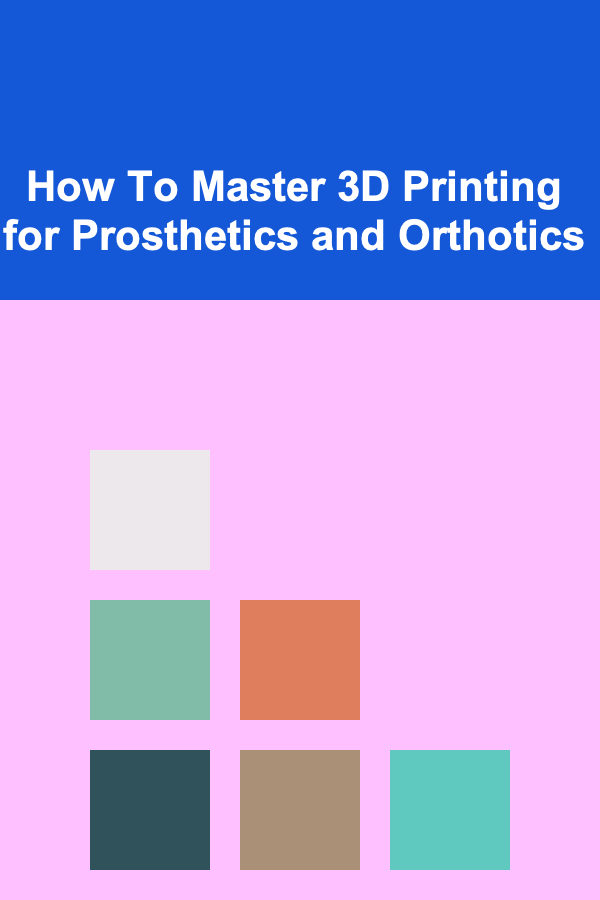
How To Master 3D Printing for Prosthetics and Orthotics
ebook include PDF & Audio bundle (Micro Guide)
$12.99$5.99
Limited Time Offer! Order within the next:

The realm of prosthetics and orthotics has been revolutionized by 3D printing technology. The ability to produce customized, patient-specific devices with speed, precision, and cost-efficiency has opened new doors for both healthcare professionals and patients alike. This article aims to explore how to master 3D printing for prosthetics and orthotics, outlining the process, challenges, and innovations involved in this field.
The Basics of 3D Printing Technology
Before delving into the applications in prosthetics and orthotics, it's essential to understand the foundational principles of 3D printing.
What Is 3D Printing?
3D printing, also known as additive manufacturing, is a process that creates a three-dimensional object by sequentially laying down material layer by layer. The design for the object is first created digitally using 3D modeling software or acquired through scanning, and then the printer translates this design into a physical object. The materials used in 3D printing can range from plastics to metals, ceramics, and even bio-materials, depending on the application.
Types of 3D Printing
There are several methods of 3D printing, each with its own strengths and weaknesses. In the context of prosthetics and orthotics, the most commonly used types include:
- Fused Deposition Modeling (FDM): This is one of the most common and accessible types of 3D printing. It uses a thermoplastic filament that is heated and extruded onto the print bed in layers.
- Stereolithography (SLA): This method uses a laser to cure liquid resin into solid layers. It is known for its high resolution and precision, making it ideal for producing detailed models.
- Selective Laser Sintering (SLS): This technique uses a laser to fuse powdered materials, usually nylon, into a solid part. SLS is particularly useful for creating strong, functional parts.
- Digital Light Processing (DLP): Similar to SLA, DLP uses light to cure resin, but it uses digital projectors to expose the resin, speeding up the printing process and making it cost-effective.
Software Tools for 3D Printing
To create an object for 3D printing, designers typically rely on 3D modeling software. Some of the popular tools include:
- AutoCAD: Widely used for engineering and product design, AutoCAD offers precise control over the dimensions and shape of a prosthetic or orthotic device.
- Blender: A free and open-source software primarily used for 3D modeling and animation, Blender is also capable of creating intricate designs for 3D printing.
- SolidWorks: This software is used to create parametric 3D designs, making it perfect for designing prosthetics and orthotics, where detailed specifications are crucial.
- Meshmixer: This tool is specifically designed for 3D printing and allows users to modify existing models or create new ones from scratch.
Applications of 3D Printing in Prosthetics and Orthotics
Prosthetics
Prosthetics are artificial devices designed to replace a missing body part, such as an arm or a leg. The goal of prosthetics is to restore function and appearance, allowing the patient to return to a normal life. Traditional prosthetics can be expensive, time-consuming to manufacture, and often lack the level of customization needed for optimal fit and comfort. This is where 3D printing shines.
Customization
3D printing allows for the creation of custom prosthetics that are tailored specifically to the patient's anatomy. By using 3D scanning techniques, medical professionals can capture a precise digital model of the residual limb, ensuring that the prosthetic fits comfortably and functions optimally. Customization can also extend to aesthetics, allowing patients to design prosthetics that suit their personal preferences, from colors to textures.
Speed and Efficiency
The traditional process of creating a prosthetic often involves multiple stages of casting, molding, and adjustment. With 3D printing, the process is significantly shortened. Prosthetists can print the device directly from the digital model, cutting down on production time and minimizing the need for manual adjustments. This speed is especially beneficial for patients in urgent need of a prosthetic or for those in remote areas with limited access to traditional prosthetic services.
Cost-Effectiveness
3D printing reduces the costs associated with traditional prosthetic manufacturing, making them more affordable for patients. Since 3D printed prosthetics can be made from relatively inexpensive materials such as thermoplastics or resins, the overall production cost is lower than that of conventionally manufactured devices. Additionally, the cost of customization is significantly reduced, as it eliminates the need for expensive molds or custom fittings.
Lightweight and Functional Designs
3D printing allows for the creation of lightweight prosthetic limbs that offer superior comfort. Traditional prosthetics can often be heavy and cumbersome, which may cause discomfort during prolonged use. With 3D printing, prosthetists can design lighter structures without sacrificing strength or durability. This enables patients to wear their prosthetics for extended periods without discomfort.
Prosthetic Limbs with Advanced Features
Through 3D printing, it's possible to integrate advanced features into prosthetic limbs. For instance, prosthetic limbs can incorporate sensors and microchips, creating smart prosthetics that can respond to movement and provide feedback to the user. Additionally, 3D printing allows for the integration of advanced mechanical systems like robotic fingers or articulating joints.
Orthotics
Orthotics refers to devices used to support or correct the function of a body part, such as braces, splints, and insoles. 3D printing is also transforming this field by enabling more personalized and effective designs.
Custom Orthotic Braces
Orthotics are often used to correct misalignments or provide support to the body. By using 3D printing, orthotists can create custom braces that precisely fit the patient's body. For example, for a patient with a specific joint issue, a 3D printed brace can be made to provide the perfect amount of support, comfort, and flexibility.
Dynamic and Adjustable Designs
One of the major advantages of 3D printing in orthotics is the ability to design dynamic and adjustable supports. For instance, a 3D printed insole can be designed with adjustable levels of cushioning or reinforcement, depending on the patient's needs. Additionally, orthotics can be printed with materials that provide different levels of flexibility, ensuring that the device performs optimally under varying conditions.
Lightweight and Comfortable
Similar to prosthetics, 3D printing enables orthotics to be lighter and more comfortable. Traditional orthotics often use rigid materials, which can be heavy and uncomfortable for prolonged use. With 3D printing, the materials can be optimized to provide a lightweight, breathable, and flexible structure. This improves the overall patient experience and encourages adherence to the prescribed orthotic treatment.
Reducing Waiting Times and Costs
Just like prosthetics, orthotics can also benefit from the speed and cost-effectiveness of 3D printing. The traditional process of creating custom orthotics can take several weeks due to the need for casting, molding, and fitting. However, with 3D printing, the production time can be reduced to just a few days, providing quicker relief for patients. Additionally, the reduction in material waste and the ability to use affordable 3D printing filaments contribute to the overall cost-effectiveness of the process.
Challenges in Mastering 3D Printing for Prosthetics and Orthotics
While the potential benefits of 3D printing in prosthetics and orthotics are clear, there are several challenges that must be addressed to fully master the technology in this field.
Material Limitations
The materials available for 3D printing are continually improving, but there are still limitations when it comes to strength, flexibility, and biocompatibility. Prosthetic and orthotic devices need to withstand daily wear and tear, and not all 3D printed materials are capable of providing the durability required for long-term use. Ongoing research is exploring new materials, such as bio-composites and flexible resins, to address these limitations.
Regulatory Issues
Medical devices, including prosthetics and orthotics, are subject to strict regulations and standards. As 3D printing in the medical field is relatively new, the regulatory framework surrounding 3D printed prosthetics and orthotics is still evolving. Manufacturers and healthcare professionals need to ensure that the devices meet safety and efficacy standards before they are used in clinical practice. This requires collaboration between regulatory bodies, manufacturers, and clinicians.
Intellectual Property and Design Protection
The rise of 3D printing also brings challenges related to intellectual property (IP) and design protection. As the ability to replicate designs becomes easier, it may lead to unauthorized copies or patent infringement. Protecting the designs and ensuring that the intellectual property rights of designers are respected is an ongoing concern in the 3D printing industry.
Training and Expertise
Mastering 3D printing for prosthetics and orthotics requires a combination of technical knowledge, design skills, and a deep understanding of human anatomy. Prosthetists and orthotists must be trained in both the principles of 3D printing and the specific needs of their patients. This requires an investment in education and professional development to ensure that the practitioners can effectively use the technology to create functional and comfortable devices.
Accessibility
While 3D printing has the potential to make prosthetics and orthotics more affordable, the technology is still not widely available in some regions. The high initial cost of 3D printers and the need for specialized training may limit the accessibility of 3D printed devices, particularly in low-income or rural areas. Efforts to expand access to 3D printing technology and training are necessary to ensure that everyone can benefit from these advancements.
The Future of 3D Printing in Prosthetics and Orthotics
The future of 3D printing in prosthetics and orthotics is incredibly promising. As technology advances, the devices produced will become even more customized, comfortable, and affordable. The integration of smart technologies into prosthetics and orthotics is likely to increase, leading to more intuitive and responsive devices. Additionally, ongoing research into new materials and printing techniques will continue to push the boundaries of what is possible.
Ultimately, 3D printing has the potential to revolutionize the prosthetics and orthotics industries, making life-changing devices accessible to more people around the world. By mastering this technology, healthcare professionals can help improve the lives of patients, offering them the opportunity to live more active, comfortable, and fulfilling lives.
Conclusion
Mastering 3D printing for prosthetics and orthotics requires an in-depth understanding of both the technology and the needs of patients. By leveraging the power of 3D printing, prosthetists and orthotists can create highly customized, functional, and cost-effective devices that improve the quality of life for people with disabilities. However, to fully realize the potential of this technology, continued innovation, training, and access to resources are necessary. As 3D printing continues to evolve, it will undoubtedly play an even more significant role in shaping the future of healthcare, particularly in the fields of prosthetics and orthotics.

How to Join Stock Photography Platforms to Sell Travel Photos
Read More
How to Optimize Storage in Your Bathroom Without Renovating
Read More
How to Stage Your Home When You Have Limited Space
Read More
How to Use Shelving Units for Efficient Family Room Storage
Read More
Start Here: The Ultimate Guide to Learning Chinese
Read More
10 Tips for Using Your Swimming Coach Planner to Track Athlete Progress
Read MoreOther Products

How to Join Stock Photography Platforms to Sell Travel Photos
Read More
How to Optimize Storage in Your Bathroom Without Renovating
Read More
How to Stage Your Home When You Have Limited Space
Read More
How to Use Shelving Units for Efficient Family Room Storage
Read More
Start Here: The Ultimate Guide to Learning Chinese
Read More